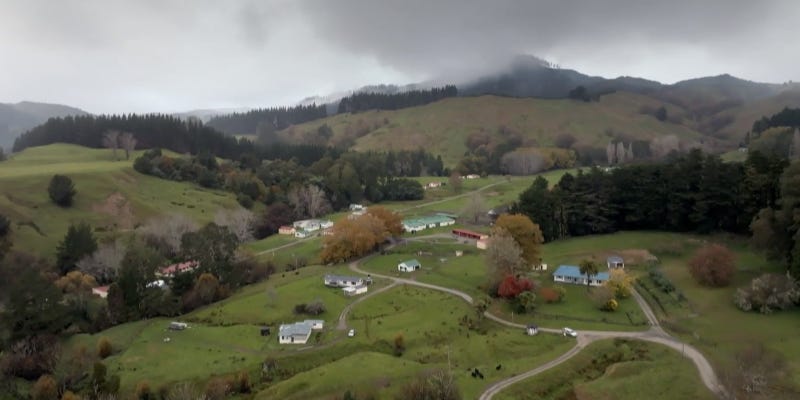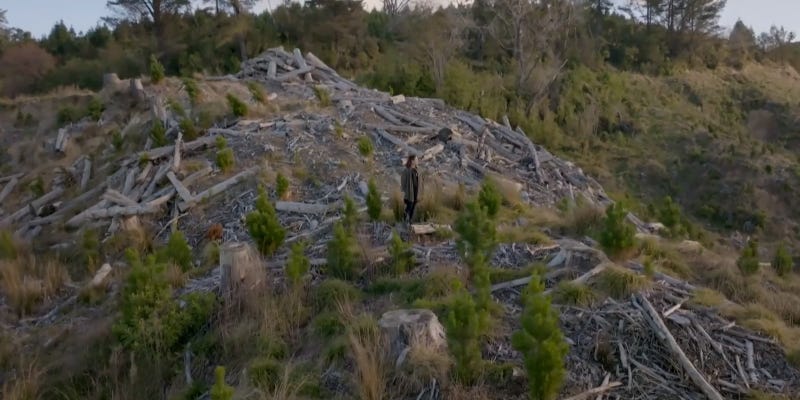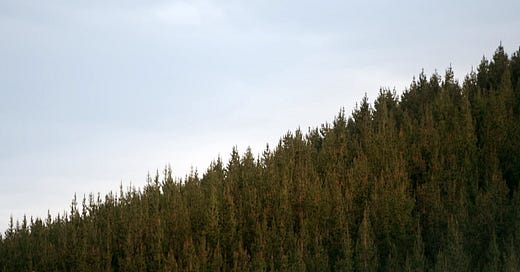IKEA and New Zealand: “It’s like another kind of colonisation”
Part VI: IKEA is buying land for pine carbon monocultures in Aotearoa.

IKEA has a target of reducing its greenhouse gas emissions by at least 50% by 2030, compared to a baseline year of 2016. By 2050, the company aims to reach net zero emissions “without using any carbon offsets”, according to IKEA’s 2023 climate report.
IKEA is using renewable electricity in its manufacturing and in its stores. It is phasing out fossil fuels in production. And it is reducing emissions from its lighting, electronic, and appliance products.
IKEA is also spending €100 million on a carbon removal and storage programme. In 2019, The Guardian reported that the money would go towards “removing and storing carbon through reforestation and responsible forest management”.
In 2022, IKEA started a five-year project with smallholder farmers in Vietnam to lengthen the harvesting rotation in acacia plantations.
IKEA argues that this is not offsetting, because it is within IKEA’s supply chain. But the reality is that IKEA is claiming that its emissions from burning fossil fuels are cancelled out by the carbon temporarily stored in acacia plantations in Vietnam. IKEA may not be buying carbon offsets, but it is relying on the false solution of carbon offsetting.
IKEA estimates that its wood-based products have a lifetime of 20 years. Even if that’s true, the greenhouse gas emissions from burning fossil fuels will remain in the atmosphere for hundreds of years. As Alain Karsenty, a researcher at the Centre for International Cooperation in Agricultural Research for Development (CIRAD), points out, “a complete neutralisation of emissions would require almost perpetual storage”. IKEA is proposing storing carbon for a few decades at most.
Another reason that tree planting is a false solution to the climate crisis, is that there simply is not enough land on the planet to offset greenhouse gas emissions by planting trees.
A 2021 Oxfam report found that it would be necessary to convert all the farmland on the planet to offset current carbon emissions. The report highlights the dangers of “net zero” targets and states that,
[T]hese targets risk being reliant on using vast swathes of land in low-income countries to capture carbon emissions, allowing the biggest emitters to avoid making significant cuts in their own emissions. ‘Net zero’ could end up being a dangerous distraction that could delay the rapid reductions in emissions that high-emitting countries and companies need to make if we are to avoid catastrophic climate breakdown. It could also lead to an explosion in demand for land which, if not subject to careful safeguards, might risk increasing hunger and fuelling land inequality.
IKEA’s carbon monocultures in New Zealand
Since 2021, IKEA has bought 23,100 hectares of land in New Zealand, to establish monoculture pine plantations.
IKEA is using the opportunity of planting trees in New Zealand to offset the CO₂ the company emits elsewhere in the world. But it is doing so without considering the local communities living on and around the land that IKEA has bought.

The recent Arte documentary about IKEA includes a visit to a 6,000 hectare farm in Gisborne, a region in the northeast of New Zealand. IKEA has bought the farm, and in a few years, a pine plantation will have replaced the village.
Kerry Wornsnop is the manager of a farming business near the farm in Huiarua. She tells the Arte documentary team that,
“This is a sheep and beef station of iconic repute. It is recognised throughout New Zealand. We’d go to a number of houses that’ll have families living in them. We have a shepherd’s school down there that has young men who come here early in their careers to learn how to farm. We’ve got tractor drivers. There are people who control the weeds and vermin here. All of that will leave. And in its place, temporary workers will come in. they will plant the farm and then everyone will leave and no one will live here ever again.
“If IKEA genuinely wants wood, we have so much wood. They are more than welcome to partner with pre-existing foresters, they can even buy pre-existing forests, just about anywhere on the East coast. There are a lot of people who’d be very happy to sell them forests.
“To be brutally honest, they’re not interested in wood, they’re interested in the investment profile of planting farmland and pine trees because it provides a net climate positive picture that they can sell to the consumers.”
IKEA has bought a dozen farms in New Zealand. Wornsnop says,
“Buying farms for the purpose of making your company look as though it is more environmentally sustainable is only sustainable for your balance sheet. It’s not sustainable for communities, it’s not sustainable for society, and it’s not sustainable for the planet. As long as these massive companies that are as big as they are and have the power that they have are not being called out on this, they will keep buying farmland and they will keep destroying communities and hoping that you don’t look close enough to notice. It’s as simple as that. It’s corporate bullshit in my view.”
IKEA plans to establish radiata pine plantations on the farms it has bought in New Zealand. In addition to generating carbon offsets, the monoculture plantations will be clearcut for IKEA furniture.
The Māori’s response to industrial tree plantations
The Indigenous population of New Zealand, the Māori, have long denounced the damage caused by these pine plantations.

Renee Raroa, a member of the Māori Ngati Porou community, says,
“So, after a harvest happens, there’s some leftover debris and it just gets piled up and left on site. There are many reasons why the debris stays on the land like this. There’s no easy ways of getting all of this debris out, because we’re on such steep slopes and hill country. After a harvest it doesn’t make economical sense for the forestry companies to try and get the debris that’s left out from these sites. And because legally there’s no accountability for leaving it on the site, this is the level that’s been allowed, and so therefore the debris is left like this to rot away or be washed away when the next storm hits.
“When I think back to the time of my ancestors, my tipuna as we say, the majority of these lands were an indigenous forest from mountain to the sea. It’s birds and insects and an ecosystem of indigenous species that we once lived in harmony with.”
Radiata pine trees were introduced to New Zealand to limit the soil erosion that was exacerbated by the clearing of the country’s native forests.
Dame Anne Salmond, an anthropologist, explains that,
“First of all, they were planted to try to hold the land together and they were planted by the New Zealand Forest Service. So they were owned by the state, these forests, and they were intended as conservation forests, but they were pine trees so they’re not really forest plantations. And so they put them in the ground. And in the 1980s, with the neoliberal revolution in New Zealand as well as many other parts of the world, they decided to privatise the forests, the plantations, and they sold them all off to New Zealand companies and then they sold them off to other companies overseas. And instead of keeping them to hold the land together, they began to harvest them. And then, of course, again, the land fell to pieces.”
Cyclone Gabrielle
In February 2023, Cyclone Gabrielle caused extensive damage in New Zealand. Three months later, forest debris and uprooted trees still littered the ground. These trees are the same species that IKEA plans to plant.

Bridget Parker, a farmer, tells the Arte documentary team that,
“Some of these logs, they would have travelled 40 kilometres in the water. And the problem is that when they jam as they roll this way and they tumble this way and when they get stuck in the river, another log hits it and jams and then another one and then another one. And they keep on filling up like a beaver dam until the water cannot kick down the river any more. And then explosion over the top. So the water leaves the river and comes out onto the land, bringing sediment and more logs with it.”
Carmen Fairlie, a Māori, says,
“As an Indigenous person, we don’t separate ourselves from the land or from the water, that we call Moana. The water is us and we are the water. The land is us and we are the land. And you’ll be able to read many whakatauki, Māori proverbs, that talk to that. Ranginui is our sky father and Papatūānuku is our mother earth. And when they’re hurt, we’re hurt. And I think that’s the difference, as an Indigenous person. It’s not just somewhere where we can come and lie on the beach and have a beautiful time under the sun. It’s actually somewhere where if that looks sick, then we are sick as a people.”
IKEA is ignoring the warnings from Indigenous people in New Zealand. The company continues to plant mainly pine trees. Renee Raroa travelled to New York to make the voices of the Māori heard at the United Nations. “When I was speaking at the United Nations, I felt all of the historic land use choices behind me,” Renee Raroa says.
In 2023 at the UN Permanent Forum on Indigenous Issues, Raroa said,
“Over the past three decades pine plantations have rapidly increased in our territories for failed erosion prevention projects, timber, and carbon credits. The New Zealand carbon credit system privileges exotic pine over native species and pine is promoted by Crown scientists as a climate and erosion solution. The only acceptable solution is an immediate moratorium on clear-felling and the restoration of biodiverse native cover.”
In the documentary, Raroa says,
“What we are seeing when large corporations are making decisions on behalf of our lands, it’s like another kind of colonisation. It’s colonisation of our forests. It’s another kind of disempowerment for the people who live in this country to be at the whim of the choices of large organisations and companies that don’t have any connection to this place.”
Re-cloaking Papatūānuku
Some Māori have decided to restore primary forests themselves. “This is the original landscape of Aotearoa,” Raroa says.
“This is what it was like before human arrival. The more of these kinds of forests we can have, the more whenua, our land and our rivers and seas will benefit from that. With a forest of this age, it is growing and will hold the soil in place. So as you move up further into the indigenous forest here, the cover is dense. The undergrowth soaks up the water. Even in our extreme weather events, we haven’t seen these soils erode away because the soil is held in harmony with the forest.”

As extreme weather events become more frequent, the Arte documentary asks, isn’t it time to spare the Earth’s most precious resources and curb the appetite of the forestry monster?
“We call that re-cloaking Papatūānuku,” Dame Anne Salmond, the anthropologist, says, “you know, mother earth, wrapping her again with her cloak of the trees.”
“So re-cloaking Papatūānuku is this idea of restoring a land that has been stripped bare and abused, kind of raped really. And doing that together. Farmers, you know, people in the cities. And we think that would be fantastic because we would have our land back. The rivers would run clear again. The birds, the forest would be singing. You know, and people would have a living on the land because the land is not being destroyed. And that’s what we’re dreaming.”






In July 2024, an Ingka Investments spokesperson told RNZ that,
"[W]e do not participate in any type of carbon farming. We do not intend to sell carbon credits as part of our routine business practices and we are not currently engaged in carbon offsetting.
"We are proud that our forests can be part of the solution to climate change, but using them as a source for other companies to offset their carbon emissions is not why we have forests."
https://www.rnz.co.nz/news/country/521256/ikea-owner-growing-its-new-zealand-forestry-portfolio
It wasn't that long ago, in an attempt to increase export income, the forests of New Zealand were torched with napalm then seeded with grass (all from the air) so that sheep could cover the land. Now it's tree plantations? This is happening all over the Global South, yes it is colonization on an industrial scale. https://www.carbonbrief.org/loggers-have-grabbed-around-1m-hectares-of-indigenous-land-in-drc/
Nothing ever good comes from pouring money out on the land, except for more debt - ecological and generational. Logging debris left behind? Privatize the profits, socialize the expenses - The Corporate Manifesto.